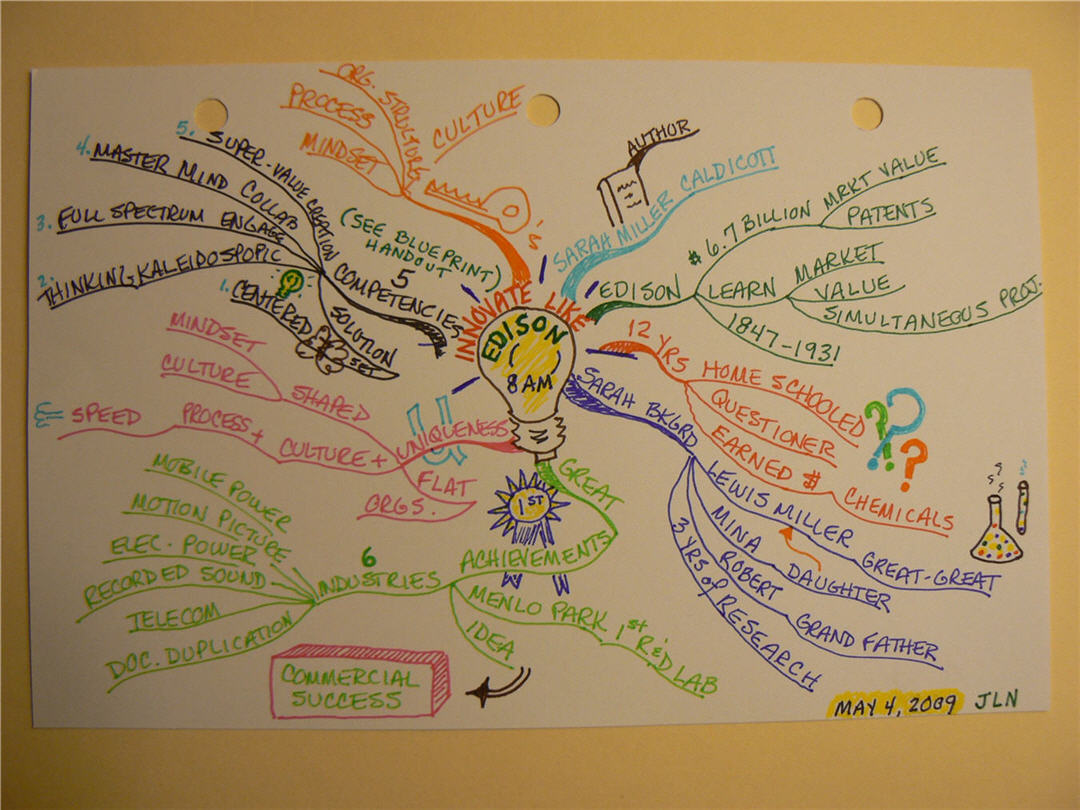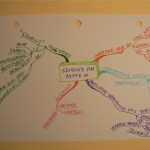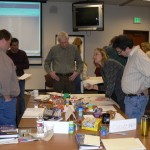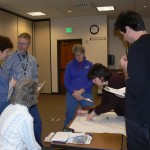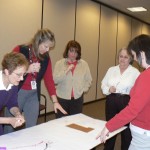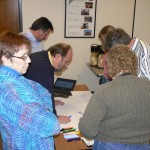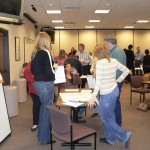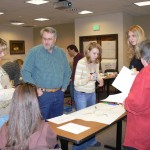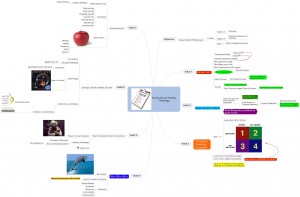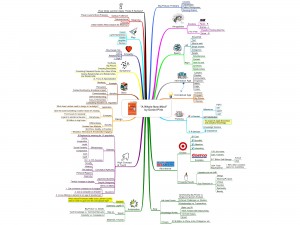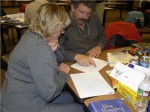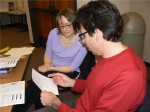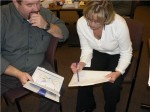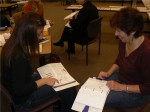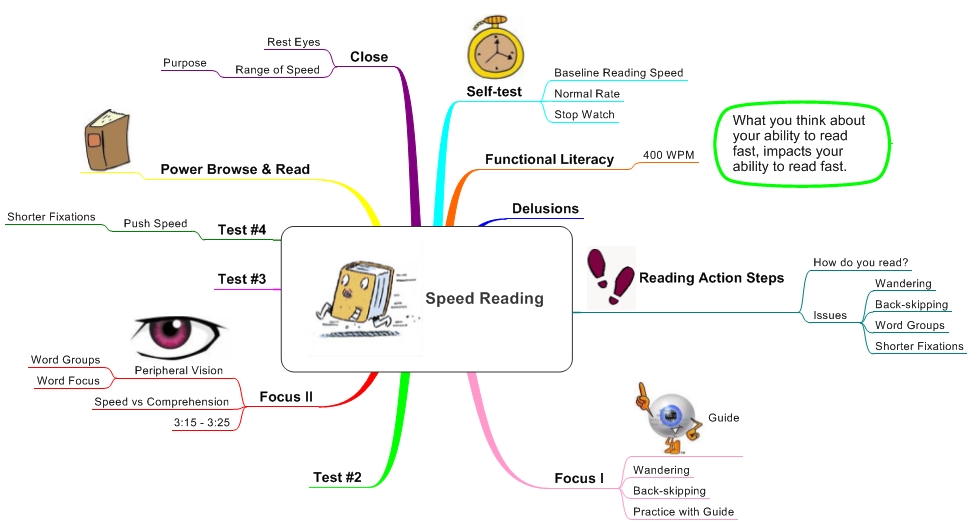An Idea Mapping Success Blogs Weblog
Mind Mapping or Idea Mapping?
14 May 2009 Author: Jamie Nast In: Differences Between Idea Mapping and Mind Mapping, Idea Mapping Example, Mind Mapping ExamplesIdea Mapping has a rich heritage in mind mapping. However I often get this question, “What is the difference between idea mapping and mind mapping?” I use the term “Idea Mapping” rather than “Mind Mapping” for several reasons.
- First I use the term idea mapping out of respect for the mappers who map strictly by the mind mapping laws. (Although many mind mappers probably don’t realize they are breaking them anyway.)
- Although the laws can have a time and place, I’ve had many a frustrated client who nearly threw out the tool because they felt their creativity was being hampered (especially by the one-word-per-line law).
- The use of the laws should be determined by the application and purpose for creating the map — not because of a set of rules.
- I think idea mapping is actually a nice descriptor of the tool and what it does.
I do share these laws with my workshop participants, but I call them guidelines and talk about a variety of situations where keeping these guidelines just doesn’t make sense. Here are a few examples:
This idea map was created by Daniel Pace during a live meeting, and you can read his full story here. My point in this example is that the purpose was speed and capturing as much detail as possible. Therefore it doesn’t make sense to waste time switching pen colors or worrying about lots of images (although he did get a few in). I’m a huge fan of color and imagery, but not when it is counterproductive. Also notice that using a single word per line does not make sense in many real-world scenarios.
Here’s another example that breaks the law that says everything must radiate from a central word and/or image. This one was created by Matt McKibbin and you can read the full story here. Matt’s message was best communicated without a single central focus.
I have lots of other examples that break other official mind mapping laws (using lined or colored paper, leaving the paper portrait rather than turning it landscape, etc.), but I think you can hear the message. Idea mapping gives the mapper a hybrid that combines the best of both worlds to free the mind to be creative and purposeful in how to map in a way that reflects the individual’s or team’s need.
(See the squidoo idea mapping group and main squidoo lenses, and flickr photos for more idea mapping examples.)
PMI New Jersey Annual Conference – Idea Maps #151-153
6 May 2009 Author: Jamie Nast In: Idea Mapping Conference Events, Idea Mapping Example, Mind Mapping Examples, Real-Time Idea MapsYesterday I was privileged to to be a speaker at the Annual PMI (Project Management Institute) Conference for the New Jersey Chapter. The top and second idea maps are ones I created live from the first speaker, Sarah Miller Caldicott, who is the author of a book titled, “Innovate Like Edison”.
The next idea map is from a session taught by Dux Raymond titled, “7 Ways to Leverage SharePoint for Project Management Success”. Thank you to Lisa and Alex from the PMI-NJ Chapter.
Idea Mapping Workshop at Larimer County Government – Part 5. Idea Map #150.
22 Apr 2009 Author: Jamie Nast In: Group Idea Maps, Idea Mapping Example, Idea Mapping Workshops, MindManagerI’ve been reporting on an unusual workshop I taught in February for the Larimer county Government in Fort Collins, CO. Up to this point I’ve shared the results of the normal 2-day Idea Mapping Workshop. Today I’ll get to the 3rd day of advanced training, leadership, and planning for Larimer’s “Idea Mapping Creativity Group.”
On Day 3 the people from Larimer who took the 2-day Idea Mapping Workshop in June of 2008 joined the February class for a final day of fun and learning. We discussed leadership trends, put the participants through some leadership role plays, reviewed Daniel Pink’s “A Whole New Mind” and how that applied to their organization. They also did a group idea map around their desire to create an “Idea Mapping Creativity Group”. The purpose of this group is “To be the mentor for and development of, and grow the use of Idea Mapping in Larimer County Government and its partners.”
The steps in creating this map were:
- Each person created their own idea map and brainstormed on what this group would look like.
- Teams of 4 merged their ideas onto flip chart-sized idea maps. Those were posted around the room.
- Then Dave Hill projected MindManager onto a screen where all could see. We began the process of merging all of the flip charts into one large idea map. We finally landed on some of the main branches.
- A team of three (Daniel Pace, Dave Hill, and Drew Davis) then did a final merge post-course. Attached you will see the results. If anyone wants a copy of this, just email me or comment on this posting.
This is the third organization in the US to have an official Idea Mapping network. The first was organized by a large automotive company in southeastern Michigan. They call themselves IMUG (Idea Mapping Users Group) and they meet quarterly and also conference in their European teams. The second was organized by Boeing and they call themselves MMIG (Mind Mapping Interest Group).
For previous postings on Larimer County see:
- 0 Comments
- Tags: A Whole New Mind, Boeing, Daniel Pace, Dave Hill, Drew Davis, group brainstorming, Group Idea Maps, Idea Mapping Creativity Group, Idea Mapping Example, Idea Mapping Users Group, idea mapping workshop, IMUG, Larimer County Government, Leadership, Mind Mapping Interest Group, MMIG, team idea mapping method
Idea Map #149 – Did We Read the Same Article (Map 7 in the Series)?
10 Apr 2009 Author: Jamie Nast In: Idea Mapping Example, Mind Mapping ExamplesThis is the 7th idea map in a series I started back in 2007. As part of the Idea Mapping Workshop participants read an article that summaries Stephen Covey’s The 7 Habits of Highly Effective People. Each idea map ends up looking quite different which initially concerns people. In fact, their maps should look different because they should be created based on the individuals unique purpose, previous knowledge of the material, style, and trust in their ability to remember what words and symbols meant at the time of creation. I literally had one participant think that I had tricked everyone into reading different articles on the same topic!
This week I taught at CPPIB (Canada Pension Plan Investment Board) in Toronto. Jason Koulouras is the Director of Data Services and the person responsible for bringing the workshop to their organization. He’s been using MindManager since the fall of 2008 and decided to create his map via software. If you want to see the others in the series, search on “did we read the same article” and you must use the quotes. Or see these links:
- Map 6 in the series
- Map 5 in the series
- Map 4 in the series
- Map 3 in the series
- Map 2 in the series
- Map 1 in the series
If you would like the MindManager version of this map, email me at jamie(at)ideamappingsuccess(dot)com. Thanks Jason!
Idea Mapping Workshop at Larimer County Government – Part 4
4 Apr 2009 Author: Jamie Nast In: Idea Mapping Workshops, Portrait Drawings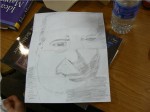 The last several weeks I’ve been reporting on a 3-day event I taught at Larimer County Government in late February. I’m still posting photos from the 2-day Idea Mapping part of this event. Today I’m sharing the portrait drawings completed by the participants. Normally few people are able to complete this activity in the time allowed, but this was an exceptional group. The personal satisfaction of being able to draw for these non-artists is undescribable. There were other portraits just a good that weren’t quite complete. Congratulations all! For an explanation of the purpose of this activity see the December 17, 2007 posting.
The last several weeks I’ve been reporting on a 3-day event I taught at Larimer County Government in late February. I’m still posting photos from the 2-day Idea Mapping part of this event. Today I’m sharing the portrait drawings completed by the participants. Normally few people are able to complete this activity in the time allowed, but this was an exceptional group. The personal satisfaction of being able to draw for these non-artists is undescribable. There were other portraits just a good that weren’t quite complete. Congratulations all! For an explanation of the purpose of this activity see the December 17, 2007 posting.
A Whole New Mind – Idea Map #148
31 Mar 2009 Author: Jamie Nast In: Book Reviews, Idea Mapping Example, Idea Mapping Workshops, Mind Mapping Examples, MindManagerI’ve been taking readers through a series about a 3-day workshop I taught at Larimer County Government in Fort Collins, CO last month. The first two days I delivered my Idea Mapping Workshop. Day three was a focus on leadership and the development of an Idea Mapping Users Group. In preparation for a discussion about leadership trends, I created an idea map of Daniel Pink’s book “A Whole New Mind”. Each participant received a copy.
This is the BEST book I read in 2008 and is in the top 10 of the best books I’ve EVER read. I created this map using MindManager and used it to share my overview of this book as it related to the issues facing Larimer County. If you print it, I suggest 11 x 17 paper.
Idea Mapping Workshop at Larimer County Government – Part 3
24 Mar 2009 Author: Jamie Nast In: Group Idea Maps, Idea Mapping Example, Idea Mapping Workshops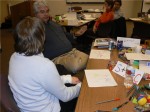 On March 9 & March 11, 2009 I began a series featuring the participants of a 3-day workshop at Larimer County Government in Fort Collins, Colorado. The uniqueness of this event will be explained in further detail in A later post, but for now I’ll continue to work through the second day.
On March 9 & March 11, 2009 I began a series featuring the participants of a 3-day workshop at Larimer County Government in Fort Collins, Colorado. The uniqueness of this event will be explained in further detail in A later post, but for now I’ll continue to work through the second day.
One of the best ways to learn to create idea maps is to share them with others. By seeing how someone captured their thoughts in a way that is different than how you mapped them helps to generate other possibilities for your future maps. Each map will vary in level of detail, amount of imagery, and structure depending on the purpose. These photos capture one of many map-sharing times during the workshop. The last photo is from an activity where each table of four made a group idea map of all the uses they could think of for idea mapping. After the quick brainstorm and capture, each group presented their findings.
Book Review of Russian Translation of Idea Mapping
20 Mar 2009 Author: Jamie Nast In: Certified Idea Mapping Instructors, Idea Mapping Book Translations, Mapping Resources, MindManager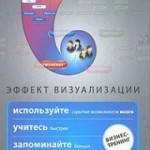 How serendipitous that one of my outstanding Certified Idea Mapping Instructors was born and raised in Russia. Larisa Brigevich and her husband arrived in the US many years ago not knowing any English. She is now the Director of the Global Research Library at Franklin Templeton and has shared her expertise and many of her idea maps on this blog. Larisa will be visiting her mom and other friends in Russia this summer and was wondering how she could explain her passion for idea mapping to them. Then the Russian translation arrived on my door step.
How serendipitous that one of my outstanding Certified Idea Mapping Instructors was born and raised in Russia. Larisa Brigevich and her husband arrived in the US many years ago not knowing any English. She is now the Director of the Global Research Library at Franklin Templeton and has shared her expertise and many of her idea maps on this blog. Larisa will be visiting her mom and other friends in Russia this summer and was wondering how she could explain her passion for idea mapping to them. Then the Russian translation arrived on my door step.
See Larisa’s book review in Russian or visit her main blog to see her many business applications.
Speed Reading – Idea Map #147
17 Mar 2009 Author: Jamie Nast In: Idea Mapping Example, Mind Mapping Examples, Speed ReadingThe following article is featured as part of the March Mindjet newsletter that will be published later today.
Use MindManager to Read and Comprehend Information More Quickly
Do you ever wish you were able to understand and respond to information more quickly? Today I’ll walk you through a map I believe is guaranteed to provide some vast improvements – Speed Reading.
We all know you wouldn’t want to speed through a great novel, but in the right circumstances this skill can save you considerable time when you choose to “turn it on.”
Here are some essential resources you’ll need to start your journey towards Speed Reading:
– A stop watch
– Four articles between 800 and1200 words in length. I copy articles from the Internet and put them into Microsoft Word. Then I go to the ‘Spelling & Grammar’ section in Word’s ‘Tools’ tab. Before running a Spell Check, I go to the Spelling ‘Options’ section to make sure the ‘Readability Statistics’ box is checked. Now I run the Spell Check and the application tells you exactly how many words you have in the document.
Establish a Baseline
Now you’re ready to measure your reading speed. Start the stop watch and read the entire article AT YOUR NORMAL READING SPEED. When finished with the article, note how long it took to read it and then calculate the number of words you read per minute.
Understand Functional Literacy
About 20 years ago the United Nations established a minimum reading rate they thought people needed to achieve in order to be “functionally literate”, 400 words per minute (WPM).. Now don’t panic if your initial reading speed was lower than this number. Mine was way below the 400 WPM baseline when I began to foster Speed Reading skills. Remember, it can only get better from here!
Be Aware of Reading’s Delusions
There are many delusions about reading which include:
- It’s impossible to read at 1000 WPM
- You should stop every time you don’t know what a word means and look it up in the dictionary.
- You need to remember what you read, word by word, line by line.
- You should never use your finger as a guide. Why? I’ve never had anyone give me a good reason.
Take Action
If you could see your eyes when you read they would move across the page in a very jerky manner, they would skip back, sometimes wander off the page, see one word at a time, and get stuck or fixated on certain words. These are the topics we’ll focus on today.
Use a Guide
A Guide is going to help with wandering and back-skipping. Think about it, when you look up a number in the phone book what do you do? Our elementary teaches didn’t know what they were talking about. Using a guide doesn’t slow you down. It keeps you focused and head in a forward direction. Take a pen, finger, or something else you’ll use as a guide and practice reading the first article you read for the baseline test above. When you’re ready, take article #2 and begin reading also using your guide. Time yourself again.
Retain Peripheral Vision
As you push your speed you may feel like you’re losing comprehension. You have to push the speed until your brain gets used to the faster pace.
Let’s try this exercise. First, start by starting at this WORD right here. How many words can you see to the left or right of the WORD without looking to the left or right but only starring at that one WORD? Notice what you can see above and below you. Still starring at the WORD, what can you see off the computer screen? Now you’re going to use your guide to point to word groupings. Even if you only take in one or two more words than you have in the past, you’re still saving time. Try this technique along with a guide as you time yourself on article #3.
Challenge Your Speed
When practicing Speed Reading using article #4 try pushing your speed even more. Try to lessen fixations, or the amount of time your eyes spend looking at word groupings.
Continue to Read
Finally, when reading a novel always thumb through it first before you read it. You’ll get a good feel for what is to come. Then begin applying these techniques to written work beyond novels, such as articles, manuals, etc. If you’re taking notes as you go, make sure you have MindManager handy to organize and capture your thoughts!
Rest Your Eyes
Rest your eyes occasionally. Remember the speed at which you choose to read will be determined by your purpose for reading.
Idea Map #146 – Conceptual Question
15 Mar 2009 Author: Jamie Nast In: Idea Mapping Example, Mind Mapping Examples, Studying for ExamsMelinda Dang shares another one of her AP Advanced Physics idea maps. She is in the 11th grade and has been using idea mapping to study for physics, Spanish, and SAT vocabulary. Search on her name to see more examples from Melinda.
Idea Mapping Blog
The purpose of this blog is to share idea mapping examples and related learning from my Idea Mapping, Memory, Speed Reading, and Certification Workshops. This blog is dedicated to my Certified Idea Mapping Instructors, my clients, Mind Mapping and Idea Mapping practitioners around the globe.
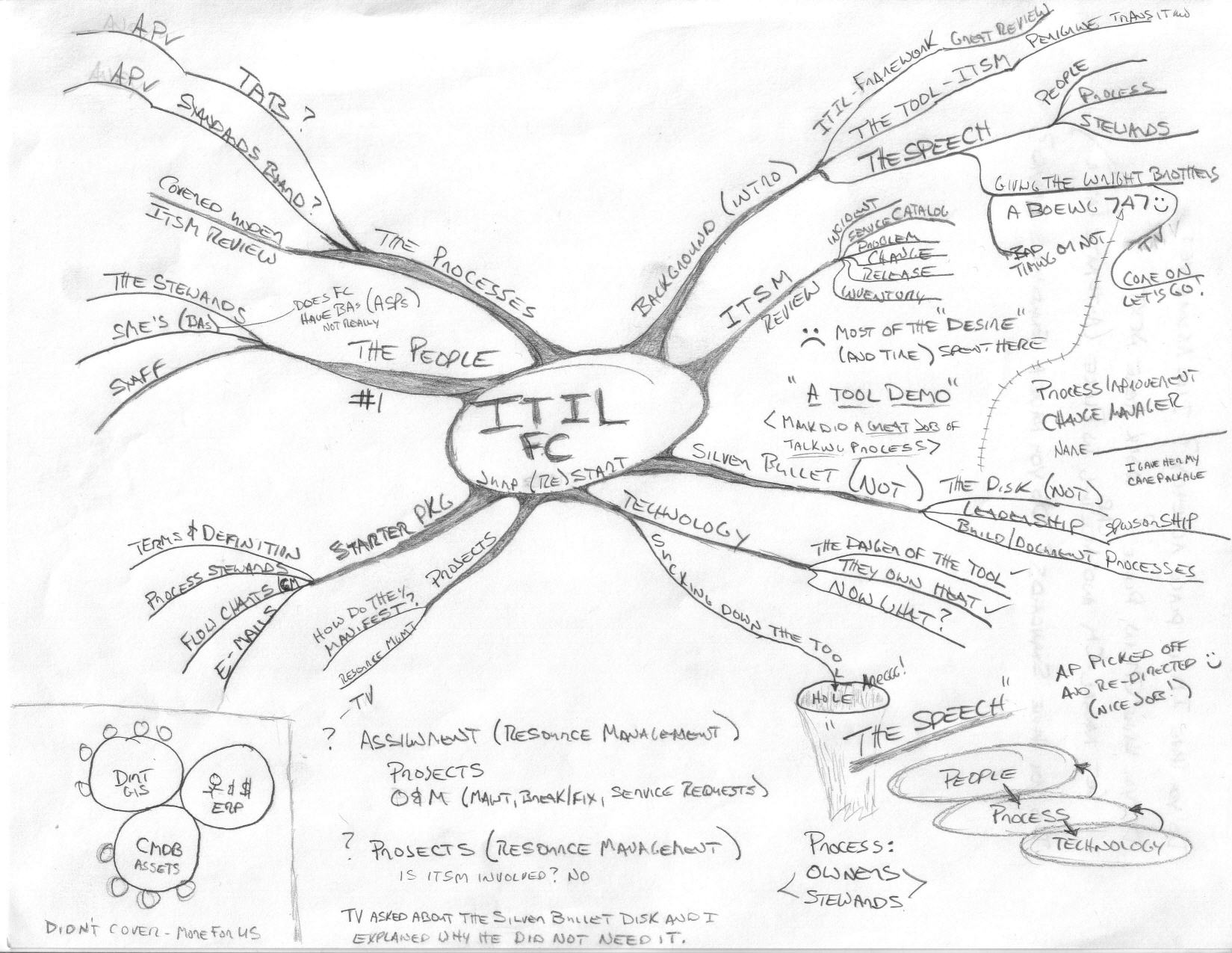

![[Ask]](http://ideamapping.ideamappingsuccess.com/IdeaMappingBlogs/wp-content/plugins/bookmarkify/ask.png)
![[del.icio.us]](http://ideamapping.ideamappingsuccess.com/IdeaMappingBlogs/wp-content/plugins/bookmarkify/delicious.png)
![[Digg]](http://ideamapping.ideamappingsuccess.com/IdeaMappingBlogs/wp-content/plugins/bookmarkify/digg.png)
![[Facebook]](http://ideamapping.ideamappingsuccess.com/IdeaMappingBlogs/wp-content/plugins/bookmarkify/facebook.png)
![[Google]](http://ideamapping.ideamappingsuccess.com/IdeaMappingBlogs/wp-content/plugins/bookmarkify/google.png)
![[MySpace]](http://ideamapping.ideamappingsuccess.com/IdeaMappingBlogs/wp-content/plugins/bookmarkify/myspace.png)
![[Slashdot]](http://ideamapping.ideamappingsuccess.com/IdeaMappingBlogs/wp-content/plugins/bookmarkify/slashdot.png)
![[Sphinn]](http://ideamapping.ideamappingsuccess.com/IdeaMappingBlogs/wp-content/plugins/bookmarkify/sphinn.png)
![[StumbleUpon]](http://ideamapping.ideamappingsuccess.com/IdeaMappingBlogs/wp-content/plugins/bookmarkify/stumbleupon.png)
![[Technorati]](http://ideamapping.ideamappingsuccess.com/IdeaMappingBlogs/wp-content/plugins/bookmarkify/technorati.png)
![[ThisNext]](http://ideamapping.ideamappingsuccess.com/IdeaMappingBlogs/wp-content/plugins/bookmarkify/thisnext.png)
![[Twitter]](http://ideamapping.ideamappingsuccess.com/IdeaMappingBlogs/wp-content/plugins/bookmarkify/twitter.png)
![[Webride]](http://ideamapping.ideamappingsuccess.com/IdeaMappingBlogs/wp-content/plugins/bookmarkify/webride.png)
![[Email]](http://ideamapping.ideamappingsuccess.com/IdeaMappingBlogs/wp-content/plugins/bookmarkify/email.png)
